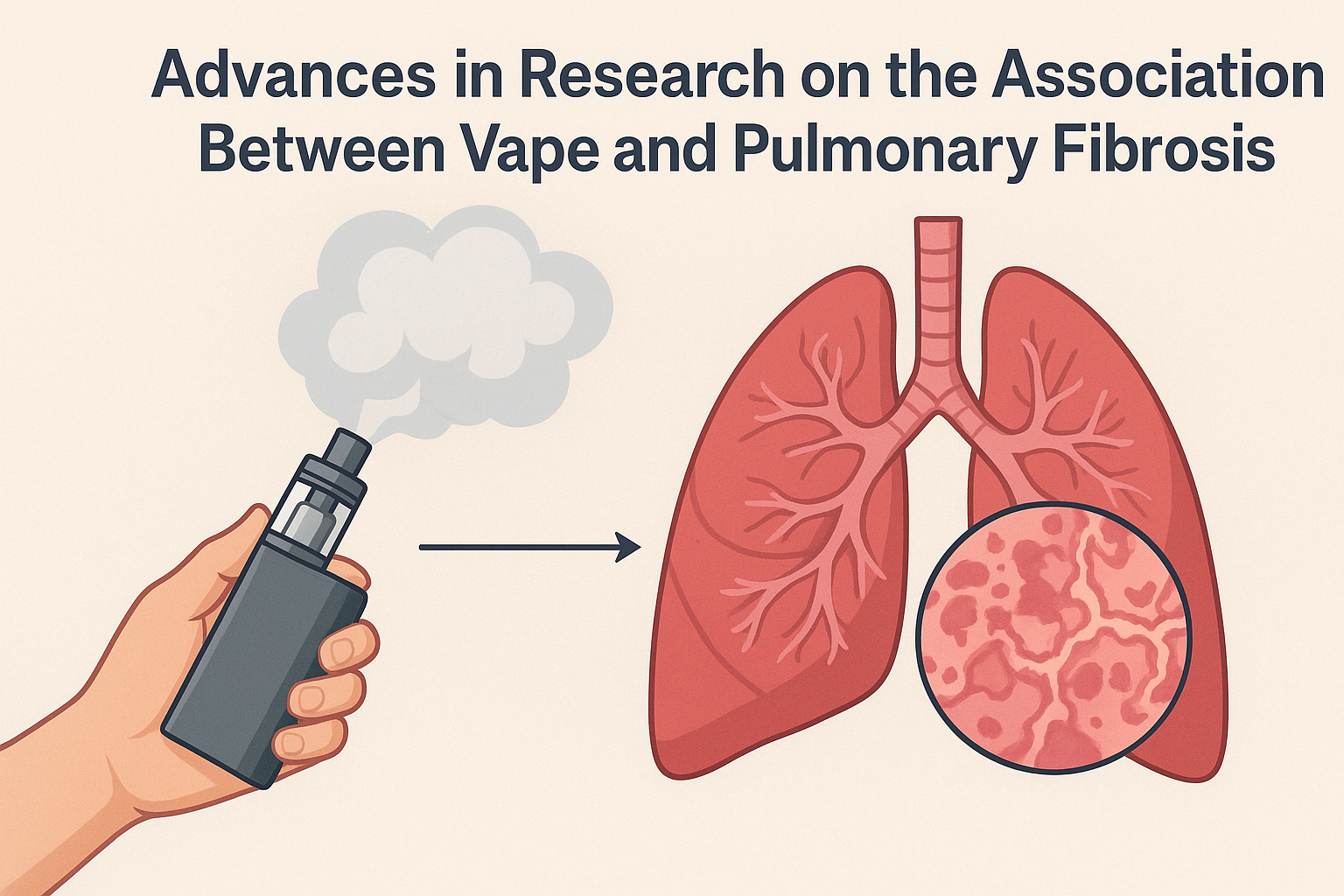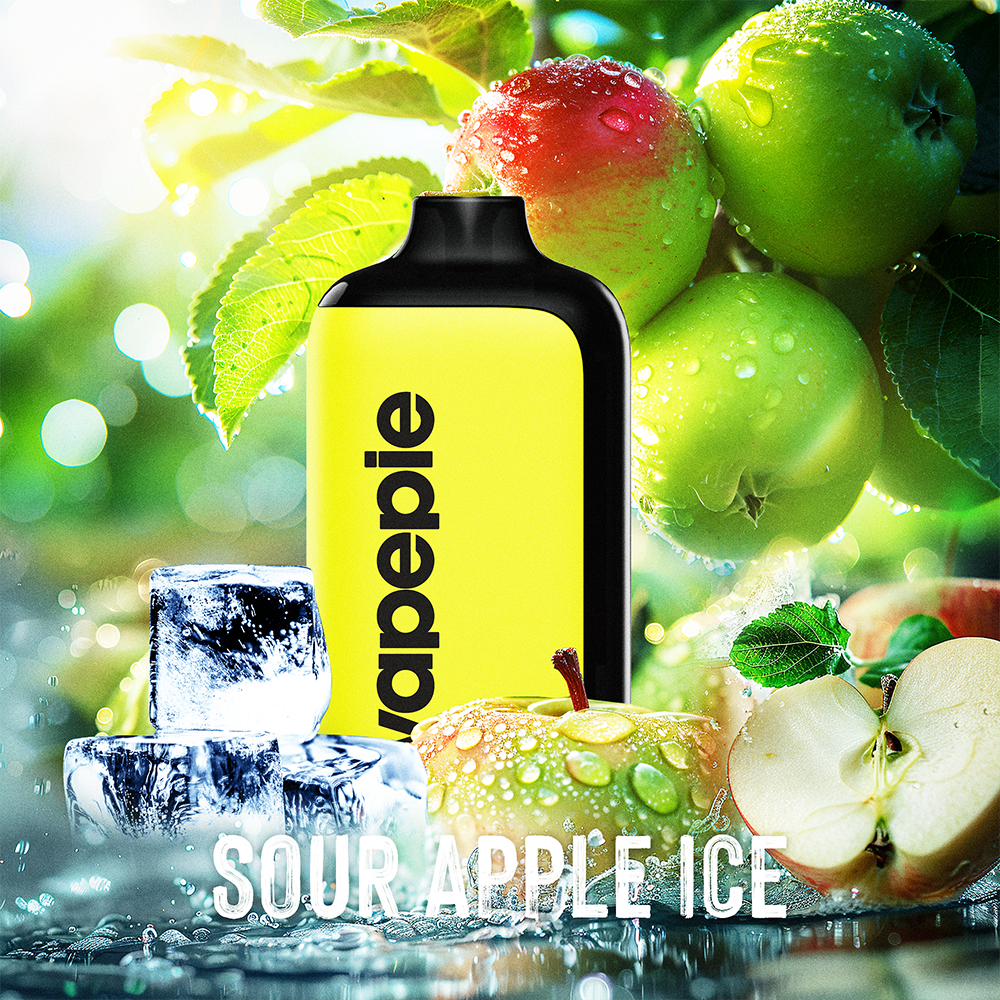
ARE YOU OF LEGAL VAPE AGE?
Please confirm that you are of legal age to purchase vaping products to access our site.

Please confirm that you are of legal age to purchase vaping products to access our site.
Some items are no longer available. Your cart has been updated.
This discount code cannot be used in conjunction with other promotional or discounted offer.
Abstract
1. Overview of Electronic Cigarettes
2. Clinical Research Progress on the Association Between Vape and Pulmonary Fibrosis
3. Mechanisms Linking Vape to Pulmonary Fibrosis
3.1 Vape and the p38 MAPK Signaling Pathway
3.2 Vape and Oxidative Stress
3.3 Vape and Pro-Fibrotic Inflammatory Factors
3.3.1 Vape , IL-6, and TNF-α
3.3.2 Vape and Nuclear Factor-κB
3.3.3 Vape and VEGF
3.3.4 Vape and Macrophage Polarization
3.4 Vape and Cell Apoptosis
4. Conclusion

Pulmonary fibrosis encompasses a spectrum of chronic lung diseases affecting the pulmonary interstitium, leading to impaired gas exchange, dyspnea, and even respiratory failure. It is characterized by persistent alveolar structural damage resulting in abnormal scar repair of lung epithelial tissue. In recent years, with the diversification of electronic cigarette (Vape) products on the market, the Vape population has expanded rapidly, and the incidence of Vape-associated lung diseases has increased annually, predominantly among young males. This has garnered widespread attention from scholars, with acute lung injury, organizing pneumonia, and other short-term effects of Vape being extensively studied. However, the long-term impacts and chronic sequelae of Vape remain unclear. Therefore, this review focuses on elucidating the potential links and mechanisms between Vape and pulmonary fibrosis from multiple perspectives, including the p38 MAPK signaling pathway, oxidative stress, cell apoptosis, pro-fibrotic inflammatory factors, and macrophage polarization. The aim is to enhance public awareness of Vape hazards and provide insights for research on Vape-related chronic respiratory diseases, including considerations for products like Vapepie.
Electronic nicotine delivery systems (ENDS), commonly known as electronic cigarettes or Vape devices, consist primarily of a mouthpiece, atomizer, e-liquid cartridge, heating element, and battery. Compared to traditional combustible cigarettes, Vape devices are more affordable and offer a wider variety of flavors, making them popular among smokers. However, over time, thousands of vapers, particularly young males aged 15-34, have developed Vape-associated lung diseases. The aerosol generated by heating the e-liquid contains not only well-known nicotine but also harmful chemicals absent in combustible tobacco smoke, such as vegetable glycerin (VG), cannabinoids, propylene glycol (PG), formaldehyde, and even heavy metals like chromium, lead, and copper. These substances irritate the airways, increase airway reactivity, exacerbate airway obstruction, and damage alveolar epithelium, often manifesting radiologically as acute lung injury, organizing pneumonia, or interstitial lung disease. Initially marketed as smoking cessation aids, surveys indicate severe public misconceptions about Vape risks, which correlate positively with the incidence of Vape-related lung diseases. Statistics show that Vape prevalence among 15-24-year-olds in China is 1.5%, while internationally it ranges from 1.5% to 25% among adolescents. This demographic not only underestimates Vape hazards but also views it as a trendy pursuit, contributing to the "youthification" of Vape-associated lung disease onset. Thus, early enhancement of public awareness regarding Vape risks and related lung diseases is essential, especially with emerging products like Vapepie gaining popularity.
Two American radiologists reviewed chest CT scans of 24 patients with Vape or Vape-associated lung injury (EVALI) and found that 96% exhibited multifocal ground-glass opacities, 55% showed pulmonary consolidation, and 29% had interlobular septal thickening. In a larger retrospective cohort study of 160 EVALI patients, 84.4% presented with diffuse ground-glass opacities, with 55.6% primarily involving the lung parenchyma, 8.8% showing peribronchial ground-glass opacities, and the remaining 20% displaying a mixed pattern combining both types.
The p38 MAPK pathway is well-established as a key player in pulmonary fibrosis. VG, one of the most common organic solvents in Vape e-liquids, was investigated by Su et al., who established two acute lung injury mouse models: one induced by VG and another by VG plus a p38 inhibitor. Lung tissues were collected, sectioned, and stained with H&E for assessment of acute lung injury and fibrosis. Results indicated that VG activates the p38 MAPK signaling pathway, enhancing neutrophil migration and promoting collagen deposition. Mucin 5B (MUC5B), secreted by airway secretory cells, participates in mucus formation and bronchial epithelial immune regulation. Overexpression of MUC5B impairs alveolar epithelial repair and is a recognized risk factor for pulmonary fibrosis. Glyoxal and methylglyoxal, common harmful byproducts of heated Vape liquids, were tested by Kwak et al.on human nasal mucosal epithelial cells (simulating airway epithelium) for 24 hours, with MUC5B levels measured via ELISA. Both compounds significantly increased MUC5B expression, which decreased markedly after pretreatment with SB203580 (a p38 MAPK-specific inhibitor). This confirms that glyoxal and methylglyoxal in Vape aerosols induce MUC5B secretion in airway epithelial cells via the p38 MAPK pathway. Therefore, we hypothesize that VG, glyoxal, and methylglyoxal in Vape aerosols, including those from products like Vapepie, activate p38 MAPK, increasing leukocyte migration, collagen deposition, and mucin secretion in lung tissue, potentially leading to acute lung injury and chronic fibrotic lung disease.
Oxidative stress arises from an imbalance between oxidation and antioxidant defenses, leading to increased expression of pro-inflammatory and pro-fibrotic factors. Long-term Vape induces persistent oxidative stress in the lungs, resulting in chronic inflammation and pulmonary fibrosis formation. Pod-style Vape devices, favored for their simplicity, produce aerosols containing heavy metals like chromium, lead, and copper. Eon et al.used CellROX orange ROS detection to measure ROS generation in airway epithelial cells exposed to pod-style Vape aerosols for 7 days, revealing significantly elevated ROS compared to controls. Sabo et al. employed mitochondrial-specific fluorescent probes to assess mitochondrial superoxides in lung epithelial cells exposed to Vape liquids, finding that nicotine and menthol concentrations increased ROS. Furthermore, most Vape devices disrupt oxidative-antioxidant balance, with the extent varying by nicotine and flavor additives. As Vape products diversify, including options like Vapepie, user demands for flavors and types complicate aerosol compositions. Chromium, lead, copper, menthol, nicotine, and certain flavor additives are confirmed to induce pulmonary oxidative stress. Thus, we infer that prolonged Vape maintains the lungs in a chronic oxidative stress state, potentially triggering chronic interstitial lung disease.
3.3.1 Vape, IL-6, and TNF-α
Tumor necrosis factor-α (TNF-α) induces multiple pro-fibrotic factors, while interleukin-6 (IL-6) fosters an inflammatory environment that promotes epithelial-mesenchymal transition in pulmonary fibrosis. To mask nicotine's taste and enhance flavors, manufacturers add ethyl acetate, eugenol, ethyl maltol, and other additives dissolved in VG or PG. Lamb et al. exposed mouse peritoneal macrophages to aerosols containing ethyl acetate and eugenol, measuring IL-6 and TNF-α via ELISA, and found significant elevations. Morris et al. used the V-PLEX pro-inflammatory panel I to quantify TNF-α and IL-6 in human bronchial epithelial cells exposed to ethyl maltol-containing Vape liquids versus endotoxin controls at 4 and 24 hours. Ethyl maltol markedly increased TNF-α (2-fold at 4 hours, 8-fold at 24 hours) and IL-6 (mild at 4 hours, 4-fold at 24 hours). Dai et al. exposed mice to 0.1 mg/L nicotine aerosols for 1 hour/day (equivalent to average adult daily intake) for 3 weeks, detecting elevated IL-6 in bronchoalveolar lavage fluid (BALF) and serum via ELISA compared to air-exposed controls. Aged heating coils in Vape devices produce formaldehyde and acetaldehyde, increasing IL-6 and TNF-α in mouse lung tissue proportionally to coil usage. Based on these studies, flavor additives like ethyl acetate, eugenol, ethyl maltol, nicotine, and aged coils in Vape products, such as Vapepie, elevate IL-6 and TNF-α in lung epithelial cells, promoting epithelial-mesenchymal transition and pulmonary fibrosis progression.
3.3.2 Vape and Nuclear Factor-κB
Nuclear factor-κB (NF-κB), a transcription factor regulating apoptosis/proliferation, is overexpressed in pulmonary fibrosis, correlating with transforming growth factor-β (TGF-β)-induced fibroblast differentiation. Kwak et al.pretreated human nasal mucosal epithelial cells with BAY11-7085 (NF-κB-specific inhibitor) before glyoxal/methylglyoxal exposure, observing reduced MUC5B via ELISA, confirming NF-κB involvement in Vape-induced MUC5B expression. Menthol, a common flavorant, increased activated NF-κB in bronchial epithelial cells after 24-hour aerosol exposure. Ma et al. imaged transgenic NF-κB mice post-24-hour Vape aerosol exposure, showing heightened lung stress responses. Intraperitoneal nicotine injection in mice for 8 weeks elevated BALF NF-κB 4.8-fold compared to controls Thus, menthol and nicotine in Vape aerosols enhance NF-κB expression in lung epithelial cells, stimulating fibroblast-to-myofibroblast transition and chronic pulmonary fibrosis.
3.3.3 Vape and VEGF
Vascular endothelial growth factor (VEGF) is crucial in angiogenesis, lung development, and injury repair. Though its precise mechanism in pulmonary fibrosis is unclear, nintedanib's anti-fibrotic effect partly involves inhibiting VEGFR 1-3, underscoring VEGF's relevance. Sayed et al.conducted a pilot study comparing plasma from vapers and healthy adults at baseline and after 2 weeks of reduced Vape, quantifying inflammatory factors and VEGF via HCYTA-60K-PX38. Vapers had higher VEGF, which decreased proportionally with reduced usage. Another study exposed rats to cigarettes or Vape aerosols (3 minutes daily for 9 months), finding elevated blood VEGF in both, though higher with cigarettes. Evidence suggests Vape increases plasma VEGF, potentially inducing pulmonary fibrosis, albeit less than traditional smoking; its risks, including in products like Vapepie, remain significant.
3.3.4 Vape and Macrophage Polarization
Macrophage polarization yields M1 and M2 types: M1 increases matrix metalloproteinase (MMP), TNF-α, and IL-1β secretion, directly promoting fibrosis; M2 enhances TGF-β and VEGF, accelerating fibroblast-to-myofibroblast transition. Both correlate with pulmonary fibrosis. Propylene glycol (PG), a common Vape aerosol component, was injected into male mice for 2 weeks by Yoon et al, who quantified arginase-1 (M2 marker) in BALF via qRT-PCR, finding elevations versus saline controls, confirming PG-induced M2 expression. BALF from never-users, asymptomatic vapers, and EVALI vapers showed M1-dominant macrophages in EVALI (promoting inflammation) and M2 in asymptomatic (promoting repair). Han et al. detected increased IL-10 and TGF-β (M2 cytokines) in Vape-exposed mouse BALF via qPCR, with flow cytometry showing higher M2 percentages post-exposure. These findings indicate Vape enhances macrophage polarization, predominantly M2, immersing lung tissue in chronic inflammation, elevating pro-fibrotic factors in airway epithelium, and inducing repeated acute injury and chronic scar repair, leading to irreversible interstitial fibrosis.
3.4 Vape and Cell Apoptosis
Type II alveolar epithelial cells act as "stem cells" in lung tissue, renewing and differentiating into type I cells during injury. Massive apoptosis triggers scar repair and fibrosis. Khalil et al. used Annexin V-FITC/PI staining to detect apoptosis in A549 cells (simulating human alveolar epithelium) dynamically exposed to Vape aerosols, revealing induced late-stage apoptosis. Zhang et al. exposed A549 cells to mint- or menthol-nicotine aerosols for 24 hours, analyzing apoptosis via Annexin V-APC/PI and flow cytometry, finding stronger induction by mint than menthol. Both increased cytoplasmic Ca²⁺, which can disrupt apoptosis-proliferation balance and induce apoptosis. Mint, menthol, and nicotine—ubiquitous in Vape aerosols, including Vapepie—may induce alveolar epithelial apoptosis, contributing to interstitial lung disease and health risks.
In public perception, Vape remains a "smoking cessation aid," with greater variety and appeal than traditional cigarettes, driving its uptake among adolescents and youthifying interstitial lung disease onset. As Vape products evolve, including innovations like Vapepie, aerosol compositions grow complex. Nicotine, menthol, VG, aged coils, additives, and heavy metals are implicated in interstitial lung disease via mechanisms like p38 MAPK activation, oxidative stress induction, apoptosis promotion, macrophage polarization enhancement, and pro-fibrotic factor upregulation. While global Vape regulations tighten, potentially reducing incidence, research on Vape-associated pulmonary fibrosis has far to go. Mechanisms remain incompletely understood, with treatments largely symptomatic (e.g., anti-inflammatory). Future studies are needed to deepen analysis and develop rational, safe, effective therapeutic and prognostic strategies, holding significant value for addicted young users.

Comment